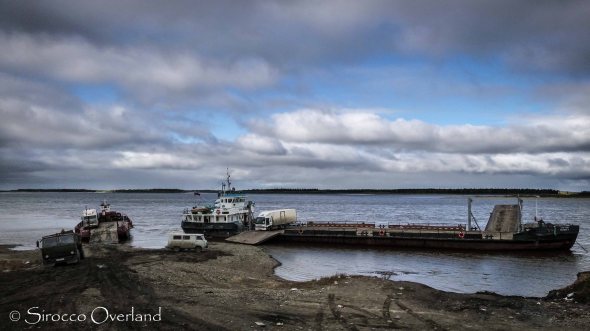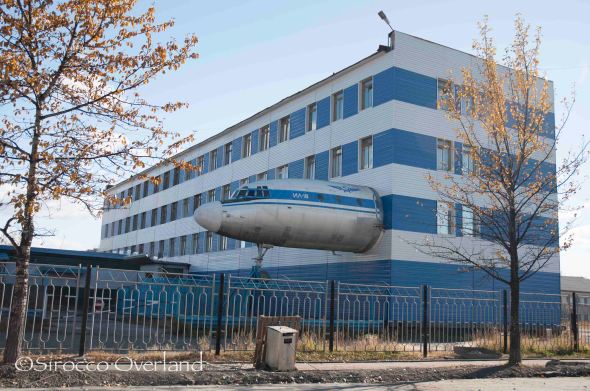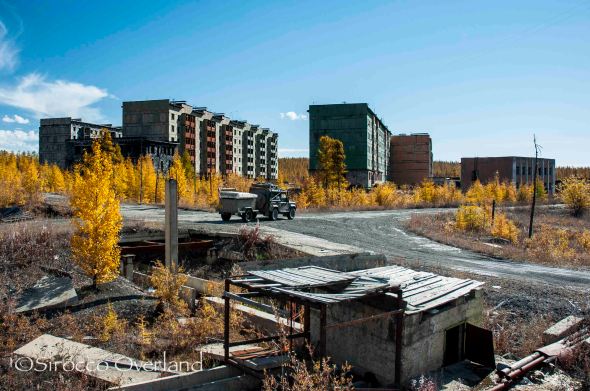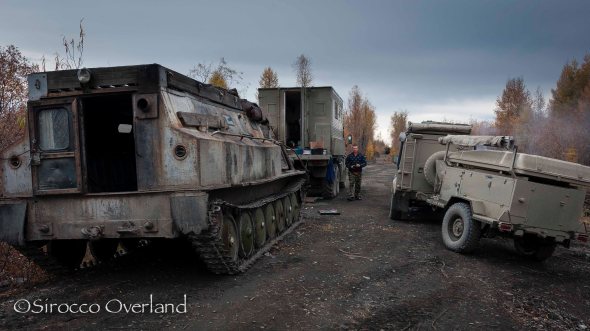Siberia Part III – To The Final Frontier Along The Road of Bones
How we took on the infamous Road of Bones during one of the wettest years in history, finally reached Magadan and then headed for Vladivostok, our final port of call.
After the Pamirs and Afghanistan, Russia’s Far North East held the next greatest allure for me personally. Motorbike accounts of the Old Summer Road and Magadan, the photos bringing to life the generosity of the people, the isolation, the remoteness, the raw beauty of the Taiga, the history, the Gulags, the ghost towns… I had to be there myself. I had to experience this.
It was actually good to be back in a reasonable-sized city. It had been a few weeks since we were in Irkutsk much further south. Yakutsk is a growing city on the edge of the Lena River and holds the title of the ”Worlds Coldest City’. All the buildings here are built on Permafrost and winter temperatures are regularly 50-60°C below zero. Luckily for us it was still late August so the temperatures were still holding in the low teens. As usual in these situations, we first scouted out somewhere cheap to stay. A few weeks earlier, I had been talking to Ed, another two-wheeled adventurer on the HUBB forum. He had provided the co-ordinates of a super cheap place that had secure parking and even a workshop. We headed straight there after getting the rig washed but couldn’t quite locate it as there were no signs. After driving in circles around the building a tall fella walked out of the gate; it was Ed. We got a room for a great rate and spent the next five days hanging out with Ed, making some repairs to the trailer and swapping out the rear brake pads on the 90 again.
We made a visit to the Permafrost museum where we got an underground tour into the permafrost. Iced caverns and hallways full of core samples, taken for research purposes. This is a great place to come and visit but bring warm clothes as the temps vary from -8 to -12°C all year round. Yakutsk is an industrial, likable city and we got unbelievably comfy, we really didn’t want to leave. However, as usual, time was cracking on and we wanted to reach Magadan some 2000km away. The end of the road east, the final frontier… Magadan.
After a huge vehicle scuffle to get on the barge (which we won), we crossed the Lena River and picked up the main highway that we would be on for the next two weeks. When I say highway, I mean a sandy potholed dirt road with almost two lanes. We picked up the pace and drove into the night before finding a spot off the road to camp. The next morning we awoke to rain which would be with us on and off for the next 14 days. We stopped to help tow some locals to the village they lived in which proved to be quite difficult for them, as the trailer was kicking up large clumps of mud, smearing their windscreen. After dropping them off at a café, we said our farewells and continued on.
The road deteriorated as we drove on north and east. When we came to the Alden River we had a little bit of a wait for the barge to come back and line itself up. It looked like one barge was out of action so again there were lots of people trying to get on this barge at 4pm. A trucker provided entertainment for all as he tried to reverse down the gravel slope to the barge, only to drop a few wheels off the side of the slope. He was hopelessly stuck and no amount of snatch recovery was going to get him out. Eventually, we all drove around him and boarded the barge, while he waited for help to arrive. We crossed the Alden River barely making headway upstream against its mighty flow. The GPS was showing 3.5 kph as the water continually flowed up and onto the barge . As it was our first time on this particular barge, it was seat-clenching stuff! At the other end we fuelled up in a small town, visited the ATM and headed off in search of a camp spot.
The Russian Taiga forms one of the world’s largest contiguous forests and is characterised by spruces, pines and larches depending on the region. Here in the Far North East of Russia, it is dominated by a vast larch forest. As would become the norm on the Road of Bones (ROB), we struggled to find a spot to pull off. The dense taiga, impenetrable in places, had been with us since leaving Irkutsk several weeks prior. We would travel 100km with trees on either side with no other way out and often so dense, you could not see any light through the trees. We often wondered how many bears and wolves we passed by that we could not see. That night we found a small side road in the darkness and performed what felt like a ten-point turn with the trailer and camped in the middle of the road.
The next day took us further north all the way to the junction with what most would call the “Old Summer Road”. The OSR is the original route of the Road of Bones. Once maintained in a drivable state the route has almost long been forgotten, except in the adventure overland circles. Each summer motorbikes and a one or two 4x4s along with the odd cyclist make their way across the 400km of broken road. When I say road, I mean collapsed bridges, swollen river crossings, subsiding gravel tracks, fallen trees, mudholes that could swallow a Kamaz truck, ghost villages and the Siberian swamps along with the super mosquitos. We stopped to fuel up and then had a chat (in bad Russian) with some Ukrainians who were rebuilding the bridge which services Tomtor approximately 150km along the OSR. They said the road was passable and that the recent flooding was no longer too bad. They offered to help us across the first river which was flowing pretty hard.
In light of this and with the clock ticking we had to make a tough decision. Drive it now or make a start from the other end, if, and when we reached Magadan? Magadan was always seen as the end of the trip for us. The final frontier. It was unlikely we would ship out of here due to cost but Magadan sits at the most easterly accessible point of the continent. An isolated port town 12 time zones from home. We didn’t know if we would even make it to Magadan. Reports a few weeks earlier from Adam Lewis (www.shortwayround.co.uk) and a handful of others were doubtful. Landslides along with washed out roads and bridges had hampered Adam’s own efforts. Some of these problem areas had been temporarily repaired but the rain continued to fall and this vast area has to drain somewhere. It was on the news in the cafes, on the front pages of newspapers, it was on the travel forums… Siberia’s worst flooding in 120 years. Great. We decided to make Magadan our priority, as the detour to Tomtor and the Pole of the Cold could easily eat seven days into our now-tight timeframe. It was early September and snow was settling on distant peaks. Not to mention the time limit on our visas, and we were still 7000km from Vladivostok, our exit route from Russia. After fuelling up at the infamous Kyubeme fuel station, we pushed on for a couple of hours into dusk.

Kyubeme Fuel stop. Open all year round… expect when there is a fuel shortage. Bring your adventure stickers!
As we progressed further north and east the nights grew increasingly colder. Surprisingly we were not that far south of the Arctic Circle in this part of Russia. It was time to collect firewood, which lay in abundance alongside the rivers from the recent flooding. Riverside camping became our mainstay for this part of the trip, as the only place you could break out of the forest or away from the marshy swamplands was where the road met a river crossing. There was always a route down onto the pebble riverbed due to hunters and fishermen creating access. I became so adept at fire starting that I could get a blaze going using only the spark from a flint and steel. My bush-craft skills were being put to the test!
After the swamp lands came the mountainous pass just west of Ust Nera. It was slow going but the road was good. We stopped in Ust Nera to pick up a few basic supplies and top up on diesel, leaving there in the early afternoon. Another riverside camp and another blazing fire that night. The next day we crossed into the Magadan Oblast and another time zone: GMT +12. We worked our way toward Susuman stopping at the forgotten city of Kadykchan, which stands at the other end of the OSR.
The road is strewn with numerous abandoned towns and villages, some completely, others with a lone inhabitant or family. The ones with a few remaining occupants were the most unsettling to drive by. It gave the impression that while everyone else was able to move when the Soviet Union collapsed, these poor souls were either unable to leave or resigned to staying. It was immensely sad, and more than a little creepy at night, to drive past a ghost town with a single window lit up on the top storey of a dark apartment building. The largest of these is Kadykchan, an abandoned city located at the end of the Old Summer Road along the Kolyma Highway.
The Lost City of Kadykchan
Like the Road of Bones, it was built by gulag prisoners in WWII, and became a booming coal-mining town housing a population of almost 11,000 miners and their families. As the coal became depleted and demand dropped, the population shrank to half in the 1980’s. An explosion at the mine in the mid-90’s sealed it’s fate, and it was closed for good. The residents had few remaining employment prospects. Winters were long and harsh, and supplies were struggling to reach the remaining inhabitants, so an exodus ensued. The Russian military evacuated the town promptly and the government handed subsidies to families to aid in relocation. By 2007 only a couple of hundred people remained, and the town was officially depopulated in 2010. Government buildings, schools, offices, hospitals and housing were all left standing, now overgrown and reclaimed by mother nature.
We drove around the houses on the city outskirts, past the power plant and into the centre along broken and twisted concrete roads. We walked into shops, the primary school and the town hall, all the time looking for signs of life. The area has an eerie, lost feel to it, due in part to personal items littering the ground. A child’s forgotten shoes left by coat pegs in the school; books on shelves or strewn across the floor of homes; weighing scales from the local shop left in the front garden. It looked as if everyone left in a hurry with only what could be carried in their vehicles, taking only the essentials. Vehicles that were not up to the job of transporting their owners sat in front of houses, tyres flat and sunken into the ground. Greenhouses, so vital in this harsh Siberian landscape to supply fresh vegetables in the short growing season, slanted to one side with glass long punched out and overtaken with weeds.
The children’s playground was especially eerie. Sat in the centre courtyard of four high-rise apartment blocks the slide sat idle, swings and a roundabout moved only by the gentle breeze of the wind, filling the air with groans and squeaks. A microwave sat on the floor in the middle of a nearby café, the roof collapsing around it, and a faded hand written menu was still taped by the door.
We stayed for a few hours exploring and taking photos. It was now mid afternoon so we got back on the road and headed on south. Stopping by Susuman we took in the strange sight of the Aeroflot airliner fuselage fixed to the side of an apartment block. Fuel prices went up 50% from here on, much to our dismay. Another couple of riverside wildcamps passed by before we reached the Dneprovski Gulag Camp.
Abandoned Dneprovski Gulag camp
Situated about 200km north of Magadan, a Stalin-era gulag camp rots at the end of a forgotten road 30km off the Road of Bones. The dirt road wound its way into an open valley, following an ambling river. Fording the river and negotiating deep mud holes, we eventually came to the ruins of a gulag camp and tin mine.
Stalin established gulags to house political prisoners in the early 1930’s, using them to provide free labour to the metal and uranium mines in Siberia, particularly in the Kolyma region. The Soviets in the west set up a large construction trust called Dalstroy (a Russian acronym for Far North Construction Trust) that would manage all construction and mining projects in the region. The operation grew to encompass all facets of economic management: surveying, transportation, port management etc. Dalstroy established approximately 80 different Gulag camps in the Kolyma, using hundreds of thousands of prisoners over the years. Like many of the more isolated Gulag operations, the camp population was a mixture of political prisoners and ordinary criminals. The port city of Magadan was constructed in 1939 to further ease the extraction of the regions valuable deposits and to more effectively transport prisoners in from the west.
Gulag prisoners were treated terribly, being forced to work long hours in temperatures as low as -50°C. They slept in rudimentary cabins with little protection from the elements and they were fed the minimum amount of sustenance to keep them alive under normal conditions. Those that survived the grueling regime still had the threat of being shot for not working hard enough (Solzhenitsyn once quoted a camp commander as stating ‘We have to squeeze everything out of a prisoner in the first three months — after that we don’t need him anymore’). Thousands of prisoners died, often left where they fell; in the case of road construction in the Kolyma region, those who perished often became part of the foundation for the road itself, leading to the now infamous name of “Road of Bones”. The M56 project lasted the entire 21 years of Dalstroy Gulag operation.
The first indication that we were close was the sight of a disused conveyor belt descending the long hill from an abandoned mine shaft above. But we were still some way off from the camp itself, a distance that would have added considerable time to an already long day for the prisoners working the mine.
At first, it was hard to make out the buildings, but a few disused watchtowers scattered across the hillsides indicated the site of the camp, which was located at the end of the valley, surrounded by hills and watchtowers on all sides. We wandered into a couple of derelict buildings that were still relatively intact: one could have been an administrative building, as it seemed better constructed than the rest; the other looked like accommodation. Most of the buildings were inaccessible as they were at best overgrown, at worst downright dangerous. Unlike Kadykchan, little evidence of the camp’s previous occupants remained. Nature had reclaimed so much of the former prison that it almost felt as if centuries had passed, not merely decades. It wasn’t a nice place to be, but there was no ominous feeling surrounding us either.
An estimated three million prisoners were sent to the gulags in the Kolyma region alone, with 700 000 recorded deaths. Over 12 million prisoners passed through the gulag system throughout the USSR, political prisoners and criminals alike. After Stalin’s death in 1953, most of them were closed down. Those mines that were still profitable were transformed into paid employment; with wages higher than elsewhere in Russia, a steady flow of workers moved to the area with their families.
As the sun began to set and the valley grew cold we decided to retrace our steps and head back out along the gravel road to the Kolyma Highway and find somewhere to camp for the night.
After 222 nights on the road we had finally reached Magadan! We stopped on the outskirts of the city for some photos before seeking out the Mask of Sorrow.
Perched on top of a hill, the Mask of Sorrow commemorates the many prisoners who suffered and died in the Gulag prison camps in the Kolyma region during the 1930-1950’s: a large face with tears pouring from the left eye in the form of small masks; the right eye portrayed by a barred window. The back side depicts a weeping young woman and a headless man on a cross. Below the Mask of Sorrow are stone markers bearing the names of many of the forced labour camps of the Kolyma, including Dneprovski as well as others designating the various religions and political systems of those who suffered there. It was a very poignant moment.
We drove into the centre to get some food and try to find somewhere cheap to stay but all the hotels were over $100 a night, which was far more than we were used to paying. We drove down to the coast looking out across the Pacific Ocean marking the end of our journey. After more than seven months driving across twelve time zones, through 22 countries heading east: we could finally drive no further. We had reached the continent’s most easterly accessible point. On reflection we should have paid for that hotel and enjoyed our destination for once instead of the journey!
Epilogue
We had little time to celebrate in Magadan as mid September was fast approaching. The nights were now down to below 0°C, we still had 5000km to go to reach Vladivostok and we still wanted to take a look at the OSR.
We had a brief look at the Old Summer Road (OSR) where we met some exploration geologists who we spent the day with chatting and eating. They told us lots of stories and showed us plenty of photos of the road ahead… it didn’t look pretty. They were basically rebuilding the road with felled trees. They had four Kamaz trucks, two Gaz 71 tracked amphibious vehicles and over 20 capable men with all the gear. It seemed a bit much for a small 4×4, me and Lisa. They did say we could call them on the Sat phone and they would bring the tracked vehicles to come rescue us! But it was too little too late. A real shame. I think this road is now in the state that only motorbikes can traverse it. It’s no longer the place for a 4×4 as most of the old road is now washed out making road rebuilding a necessity. At the time we thought we may still get to Tomtor from the other end but after waiting over 24 hours at the Kyubeme fuel stop for diesel to arrive we decided that we better push on. We bought 40 litres from the construction workers we met earlier in the week which was enough to get us a further 400km to the next fuel stop.
The remainder of our trip consisted of persistent rain, cold nights, and appalling road conditions. We also blew three shocks, cracked both headlights, chewed through another set of rear brake pads and the bodywork on the trailer began to fracture causing the doors to swing open as we drove along! Things were a little easier (certainly cleaner) when we reached the Trans-Siberian as we proceeded to bounce our way east to Vladivostok.
It was a great relief to finally arrive at the home of Vasily Radashevsky. Vasily is a renowned polychaete biologist (marine worms to you and me) who Lisa had befriended at a taxonomy workshop a few years previously. Vasily was at a conference in Australia at the time so we were welcomed by his wife, Vera, and daughter Tanya. They put up with us and our dirty, road weary ways for two weeks! We also took over their garden as we stripped and cleaned everything ready for shipping. There was gear everywhere. We really couldn’t have done it without them and are exceptionally grateful for their hospitality.
The Landy was finally packed into the container along with six other bikes. We had two 35 litre bags packed with everything we would need for the next couple of months – quite a lot less than we were used to travelling with! A good friend had invited us to visit her in Hong Kong, so with flights booked we had nothing left to do but keep our fingers crossed that the Landy would be there at the other end!
Our 2013 overland trip had come to a close and that was quite hard to get my head around. Three years of preparation, nearly nine months and 42,000km along with all our savings done and gone. The good news was that we were heading for a new life in Australia so we had something to look forward to.
It was a very strange moment flying out of Vladivostok with the knowledge that all our belongings were in a container on their way to Melbourne, Australia. We had also been speaking Russian continually for 3-4 months and we found speaking constructed English quite hard for the first week in Hong Kong. Leaving Russia for a westernised world was also another hurdle. Since leaving Europe, from Georgia onwards, we had become very accustomed to the old Soviet way of life and highly regarded their straightforwardness, generosity and kindness. We became used to isolated regions, lack of power, low population densities and only finding/needing the basics in life. We were both quite saddened to have to leave this world behind. A simpler world, the world of a nomad or a vagabond, call it what you will.
People often say ‘A once in a lifetime trip’ when I tell them about it, and I suppose it is because we will never likely repeat it, not exactly anyway. But if someone was to give me the money to do it again, I would drop everything and do it all again tomorrow, every single kilometre of it. No hesitation.
















































Pingback: Horizons Unlimited - The HUBB